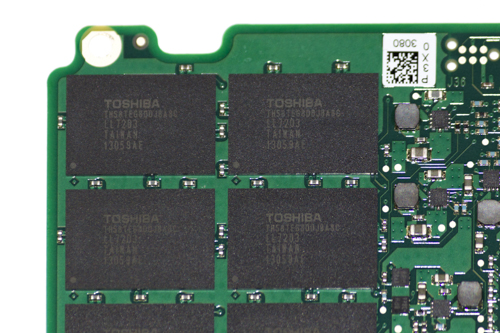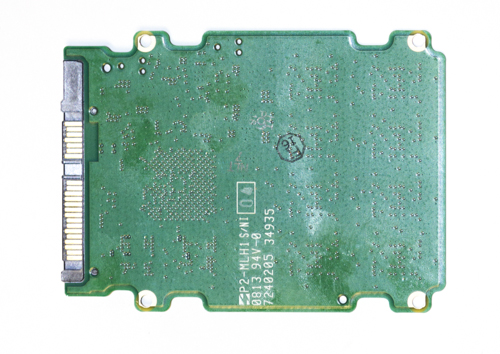Seagate 600 Pro-Series 200 GB SSD Review: For The Enterprise
After years of halfhearted attempts to join the solid-state storage market, Seagate is finally ready to reinvent itself with a new family of SSDs. The first one we're looking at is the enterprise-class 600 Pro. Does this 200 GB drive impress our team?
Inside Seagate's 600 Pro SSD
When we received Seagate's 600 Pro, we noticed something unique: unlike other vendors that use four screws to hold the PCB and chassis together, this drive employs clips bent into the sheet metal to connect the top plate.
As you can see, you'll almost certainly damage the back plate if you try to remove it. That plate is constructed using much thicker aluminum than what we're used to seeing, but it's probably necessary to keep the back plate attached. The area where the clips attach to the top is filled with blue foam, which we can only assume is for vibration dampening in big server enclosures.
Seagate makes it a point to talk about its build-once use-many philosophy. This means we expect to see the 600 Pro's internals used as a foundation for other products, including the consumer-oriented Seagate 600 SSD.
Front and center, we find the LM87800AA from Link_A_Media, which is actually now known as SK hynix memory solutions. This is the same controller Corsair uses in its Neutron and Neutron GTX drives. Even though SK hynix memory solutions can technically deliver the same sort of solution as SandForce, Seagate claims it was heavily involved in the firmware development. A thermal pad sits between the controller hardware and enclosure to help dissipate the device's heat.
Two Micron DRAM packages sit next to the controller, each hosting 128 MB of cache for a total of 256 MB. The 400 and 480 GB drives come with 512 MB of cache. Just below the DRAM are four surface-mount capacitors that allow the 600 Pro to flush its write cache to NAND in the event of a power failure.
The 600 Pro's eight NAND packages correspond to the SK hynix memory solutions controller's eight memory channels. Seagate is using Toshiba's Toggle-mode NAND manufactured at 19 nm. Given 64 Gb density, each of the eight packages contains four die, totaling 256 GB of raw flash.
All of the drive's components are on the top; there's nothing to see around on the back.
Get Tom's Hardware's best news and in-depth reviews, straight to your inbox.
Although Seagate went light on specifics, the 600 Pro does provide ECC and other data path protections that help the drive recover from bit failures. One thing we found interesting, and perhaps a carry-over from Seagate's experience in the magnetic disk space, is the publication of Annualized Failure Rate (AFR). The company rates its 600 Pro with an AFR of 0.58%, which roughly equals a 1.5 million-hour MTBF. That might sound impressive, but Seagate's Savvio 15K.3 has an AFR of 0.44% and a two million-hour MTBF.
Current page: Inside Seagate's 600 Pro SSD
Prev Page Seagate's 600 Pro SSD: Enterprise On A Budget Next Page Test Setup, Benchmarks, And Methodology-
mayankleoboy1 1. Would it have made sense to add more DRAM to increase performance ? On a SSD this expensive, 1GB RAM would hardly add 20$ or so.Reply
2. On the first page, the fourth paragraph :"Today, Seagate ........... bench today."
You completely went over my head. It appears you are just throwing names around. Maybe reword that para again ? or explain here ? :) -
Lrxst WD bought SiliconSystems in 2009 and has been making WD branded SiliconDrives. I put one in my i5 build shortly after they came out, and I feel like I am the only one who bought one for home use. They still make them, but are focusing on embedded systems at this point. Maybe Seagate will have more luck, but there are a lot of well established players already. I'm pretty luke-warm on Seagate. How do you know your Seagate SSD is on the verge of failure without the telltale Seagate Click of Death®?Reply -
drewriley mayankleoboy11. Would it have made sense to add more DRAM to increase performance ? On a SSD this expensive, 1GB RAM would hardly add 20$ or so.2. On the first page, the fourth paragraph :"Today, Seagate ........... bench today." You completely went over my head. It appears you are just throwing names around. Maybe reword that para again ? or explain here ?Reply
1) With the DRAM-to-NAND ratio already being 1MB->1GB it is already fairly aggressive, it may have helped with performance consistency, but I don't think you would see much improvement.
2) Basically, Seagate announced 4 products today
a) Seagate 600 Pro - Entry level, read-focused, enterprise SSD
b) Seagate 600 - Consumer SSD, which we will have reviewed tomorrow
c) Seagate 1200 - High-end, dual-port, 12Gbps SAS SSD
d) X8 Accelerator - High-end plug-in PCIe SSD
Hope this helps.
Drew -
drewriley LrxstWD bought SiliconSystems in 2009 and has been making WD branded SiliconDrives. I put one in my i5 build shortly after they came out, and I feel like I am the only one who bought one for home use. They still make them, but are focusing on embedded systems at this point. Maybe Seagate will have more luck, but there are a lot of well established players already. I'm pretty luke-warm on Seagate. How do you know your Seagate SSD is on the verge of failure without the telltale Seagate Click of Death®?Reply
You're the one that bought that drive :-) You are right on point with WD/Silicon Systems. They were primarily an embedded flash vendor prior to acquisition. If you look at their webpage, you will see that they only offer SLC-based drives.
-
mayankleoboy1 drewriley1) With the DRAM-to-NAND ratio already being 1MB->1GB it is already fairly aggressive, it may have helped with performance consistency, but I don't think you would see much improvement.2) Basically, Seagate announced 4 products today a) Seagate 600 Pro - Entry level, read-focused, enterprise SSD b) Seagate 600 - Consumer SSD, which we will have reviewed tomorrow c) Seagate 1200 - High-end, dual-port, 12Gbps SAS SSD d) X8 Accelerator - High-end plug-in PCIe SSDHope this helps.DrewReply
Thanks, Drew. This made the paragraph clearer. -
thecynicalmonk "For The Enterprise" Bout time the USS Enterprise got an upgrade! No more waiting for the holo-deck to buffer!! lolzReply -
danwat1234 "For The Enterprise", lol they use isolinear rods and chips. I doubt these SSDs can compete against those at any angle. Maybe from a reliability perspective.Reply -
rgeiken I have had several Seagate drives in the past and they both had reliability issues after their first year. Right now, Seagate is on my Do Not Buy List!!!! For any magnetic hard drive, I would select WD. Have had pretty good luck with that company. When any company produces parts that fail prematurely and then don't supply a replacement promptly, then they are on my DNB List. I will probably buy a Samsung SSD shortly, since with Samsung I have always had good performance and reliability.Reply -
bards1888 The DRAM on the SSD is typically only used to store the indirection table, it does not cache user data.Reply





